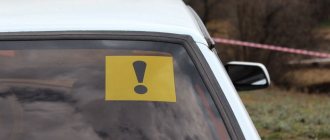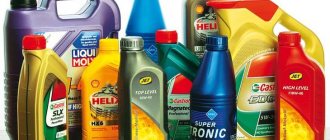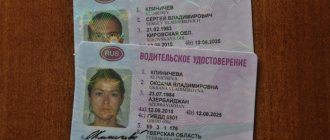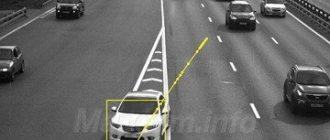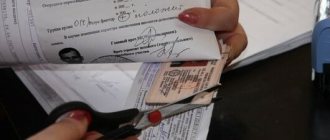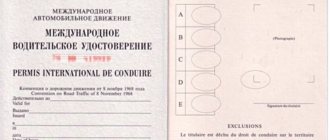Without passing a technical inspection of the vehicle, you will not be able to obtain an MTPL policy, and therefore you need to undergo it earlier. All vehicles that have passed the inspection are included in a single database. Passing a technical inspection is not a problem now, there are many private operators and the whole procedure takes about 40-45 minutes, but prices for services can vary significantly. Some people prefer to undergo a technical inspection quickly and comfortably, while others prefer a budget option. Regardless of whether the driver is the owner of the car or just a trusted representative, he can now choose the operator himself to undergo technical inspection. We will consider what documents are needed for technical inspection in 2020.
Take with you:
- General passport
- Vehicle passport
- Power of attorney if the car is registered to another person
- Receipt of payment
You do not need to provide the operator with your driver’s license, medical certificate, or MTPL policy.
Before carrying out a technical inspection, an agreement is concluded, which stipulates all the conditions and terms of the inspection, the rights and obligations of the parties, the cost of services and other standard details of the agreement. You should not blindly sign such a document without reading it, because all services may not be indicated there, for which you will then have to pay extra.
Why is a technical inspection necessary?
Vehicle technical inspection is a procedure for checking and monitoring the condition of vehicles to ensure they comply with mandatory safety requirements. Based on its results, a decision is made on whether the car should be allowed to participate in road traffic. The timing and procedure for organizing and passing a technical inspection are regulated by No. 170-FZ “On Vehicle Maintenance and Amendments to Certain Legislative Acts of the Russian Federation.”
In accordance with Art. 4 it is carried out in compliance with the following principles:
- possibility of free choice of maintenance operators;
- price and territorial availability of services;
- free information about the procedure and timing of the procedure;
- operator competition;
- responsibility of operators for providing a diagnostic card to the owner of a vehicle that does not meet safety requirements.
The maximum cost of technical inspection is within the competence of regional authorities and depends on the category of vehicle.
Rules for passing foreign cars
We would like to note that owners of cars registered in a foreign country, in order to move freely within the territory of the Russian Federation, must have a policy called “Green Card”, otherwise they will have to buy compulsory motor liability insurance. And to obtain compulsory motor insurance for a “foreign” car, the owner will still be asked to provide a valid international inspection certificate.
There are two possible events:
The first option is that the owner of such a car must enter Russia, and he must have a Green Card policy in his hands. Literally all countries on the border with Russia are directly members of the Green Card.
The second option is the availability of international type maintenance. This form of document has been published since November 13, 1997. In addition, the manuals contain some information about the contract. If a car enters the Russian Federation without a Green Card and without a technical inspection certificate, such a vehicle can operate on the territory of the Russian Federation according to the general rules.
If you want to save money on the inspection service next time, contact the same expert where you had the inspection again, he will check only those elements that were not checked the first time, the price for the service will be lower. And if you go to a new specialist, he will check the entire car, and accordingly you will have to pay the full amount of money.
Frequency of technical inspection
Inspection for compulsory motor liability insurance is carried out in relation to the age of the vehicle. If it is under three years old, it is not necessary to undergo the procedure (Article 15 No. 170-FZ). Owners of cars aged 3 to 7 years must receive a diagnostic card every two years. The exceptions are cars equipped with special flashing lights, and vehicles used for driving lessons (clause 3 of Article 15 No. 170-FZ).
Owners of the oldest cars (over 7 years old) need to show them to assess their technical condition annually. Vehicles with more than 8 seats, operated for commercial passenger transportation, and special equipment intended for the transportation of dangerous goods are subject to inspection every 6 months.
Regularity of the procedure
Do I need to undergo a timely inspection for a new car and how often will I have to visit an expert? Changes in legislation also affected these issues. Inspection of a new car is not carried out today, and as for the timing, today the frequency of inspection is as follows:
- Vehicles of category “B”, motor vehicles, trailers and semi-trailers must undergo inspection 3-5-7 years after release, and then annually;
- Category “C”, training vehicles and vehicles with special signals must undergo technical inspection once a year;
- For vehicles carrying passengers or dangerous goods - every 6 months (this frequency of maintenance is related to the specifics of these categories).
A new car that is less than three years old does not need to undergo inspection.
Violation of the procedure for inspecting equipment will result in the owner not being sold an auto liability policy, and he will be held administratively liable for lack of inspection.
How is the technical inspection carried out?
Only accredited operators and dealer centers have the right to perform technical inspection of vehicles, a full list of which is available on the official website of RSA. Before starting the procedure, you must present the required documents - the owner’s passport, PTS or STS (Article 17 No. 170-FZ).
The procedure for passing a vehicle inspection requires the participation of an expert who checks the car, taking into account the mandatory criteria. Among them:
- checking the presence of a fire extinguisher and first aid kit;
- diagnostics of optics and operation of the brake system;
- checking the condition of locks and compliance with technical fluid standards;
- diagnostics of the condition of the suspension and steering wheel;
- measurement of exhaust toxicity;
- determination of tread pattern height;
- instrumental control.
Important! On May 4, 2020, updated inspection requirements came into force. Now it is impossible to dismantle the standard windshield wipers and washers, a ban has been introduced on sticking film on the lenses, all wheels must have identical tires, and the ESD or power steering is fully operational.
Based on the results of the technical inspection, the owner is issued a diagnostic card. If the vehicle fails the procedure, its owner is given 20 days to correct the problem. When you contact the operator who previously identified the problem again, only the faulty unit will be checked.
Malfunctions that may interfere
You will not be able to pass a vehicle inspection in the following cases:
- the car has tinted headlights, front, side or windshield
- non-standard parts that are not installed by the manufacturer
- red turn signals
- headlights have cracks
- crack in the windshield
- no fire extinguisher or emergency sign
- non-standard xenon
- leaky exhaust system
- there are side steps around the perimeter, as well as the presence of kengurin
- if there is a discrepancy on one axis of the difference in braking forces
- license plates are unreadable (worn or peeling).
This is not a complete list, but we have given some of the most common reasons for refusal to undergo a technical inspection by drivers, from which, we hope, you understood the main point.
What is a diagnostic card?
A diagnostic inspection card is a document containing a conclusion on the vehicle’s compliance/non-compliance with current safety requirements. Certified by the signature of the expert who performed the vehicle inspection. It is compiled in two copies on paper and also has an electronic form. One of the options must be kept by the technical expert for three years. The document remains valid even if the owner of the vehicle changes before its expiration date.
Important! If the diagnostic card confirms the impossibility of operating the vehicle, it must contain a list of problems that contradict mandatory safety requirements.
The sample diagnostic card was approved by government decree, and the rules for filling it out are regulated by Order of the Ministry of Transport No. 274 of 08/21/2013. This document is necessary to obtain an MTPL policy, since based on its presentation, an agreement is concluded with the insurance company.
Inspection of vehicles registered in other countries
Specialists working in the field of automobile law are often asked whether owners of vehicles with foreign license plates need to undergo inspection, and how to pass inspection of such equipment?
Such cars must have a green card. The current document eliminates the need to purchase a compulsory motor liability insurance policy. To buy insurance for such a car you will have to present an international technical inspection certificate.
Otherwise, you will have to undergo maintenance on a general basis. The cost of the examination will be influenced by the type of vehicle and the region where the procedure is carried out. This is a very important point, since sometimes the cost of technical inspection for UAZ cars registered in one region will be the same as the procedure for a foreign car operated in another region.
Responsibility for lack of technical inspection
Current Russian legislation establishes administrative liability for the lack of technical inspection of owners of vehicles with more than eight seats, which are intended for passenger transportation, as well as specialized vehicles involved in the transportation of dangerous goods. In accordance with Art. 12.1 of the Code of Administrative Offences, they may be fined in the amount of 500 to 800 rubles.
All other motorists are not punished for failing to pass a technical inspection. However, without a valid diagnostic card, they cannot obtain insurance. Driving without a compulsory motor liability insurance policy is classified as an administrative offense (Article 12.37 of the Administrative Code). The fine is 800 rubles.
Important! A fine for driving without compulsory motor insurance (and, logically, without a technical inspection) is imposed on the person driving the vehicle, and not on the owner of the car.
In order to increase discipline in complying with the requirements of the law and passing technical inspection, in 2020 the government prepared a package of amendments aimed at tightening the liability of drivers who ignore this procedure. In particular, it is planned to fine car owners large sums and establish the liability of operators for illegal trade in diagnostic cards (within 5-10 thousand rubles). The norm will be in Art. 12.5 Code of Administrative Offences.
A note will be added to the content of the article that the fine should be collected no more than once a day. It is possible that the diagnostic card will be included in the list of documents required to be presented to traffic police officers. It is possible to introduce automatic verification of the fact that it was issued by cameras, similar to how this is beginning to be implemented with auto insurance policies.
Important! The bill specifies that the amendments will come into force only one year after their adoption. Therefore, the actual start time of their action is no earlier than 2020.
In accordance with the provisions of Art. 14 No. 40-FZ, the insurer has the right to address the culprit of the accident with regressive claims in order to compensate for expenses incurred, if at the time of the accident he did not have a valid diagnostic card. This is possible for owners of taxis, buses and other vehicles with more than 8 seats, as well as special vehicles transporting dangerous goods.
What should be available
A fire extinguisher is a must-have item in the trunk of a car. It is located in the luggage compartment.
We invite you to read: The policyholder and the owner are different persons under compulsory motor liability insurance or not: who are they, who can enter into an agreement on the policy, and what rights do they have?
The expert checks both its presence and compliance with these conditions:
- The fire extinguisher must not be expired. The shelf life is no more than 2 years, indicated by engraving on the case;
- The fire extinguisher is accompanied by a passport and a certificate of conformity;
- The pressure in the fire extinguisher must be normal. This reading is detected on the pressure gauge using a green arrow;
- the seal remains intact.
A first aid kit is the second most important element, which is certainly important for the driver and passengers.
But at the service station the availability of a set of medications is not checked. Therefore, the complete set depends on the preferences and diagnoses of car enthusiasts.
Standard equipment includes:
- non-sterile bandages;
- sterile bandages;
- dressing bags, hemostatic tourniquets;
- bactericidal adhesive plasters;
- gauze napkins;
- Rolled adhesive plasters.
All motorists need a warning triangle. It is made with reflective elements and can be easily installed in case of an accident on any road surface.
Online technical inspection service
There are a huge number of offers on the Internet to undergo technical inspection online without providing a car. The owners of such resources promise to issue a diagnostic card only based on the information provided by the customer. In this case, the form will be absolutely legal and included in the federal database. As proof of this fact, it is proposed to go to the traffic police website and enter the 15-digit document code. However, anyone who decides to use such services exposes themselves to great risk.
There is always a possibility of running into scammers who will issue a fake DC that is not in the EAISTO database, and this is a waste of nerves and money. In addition, the cost of such services can be significantly higher than for a real technical inspection. And most importantly, a remote “MOT” cannot detect problems with a car, the owner of which puts himself, his passengers and others at risk.
The safety of people is the paramount principle in organizing road traffic. One of its most important components is the serviceability of the car. A technical inspection helps make sure that everything is in order or identify malfunctions, so do not neglect this procedure.
What to do if the transport does not pass the procedure
Documents that help you pass a technical inspection must prove both ownership of the car and the right to drive. Sometimes, to organize diagnostics, it is enough for the owner to write out a power of attorney for one of the drivers. But this paper does not guarantee the success of the legal procedure.
In a situation where the technical inspection is not passed due to a vehicle malfunction, only the owner is to blame. It is his responsibility to correct the omission within 20 days after the failure.
In this case, the service station will not charge a duplicate amount for the cost of the service. A repeat visit will cost 200-300 rubles.
There they will add technical fluids, install sealed brake hoses, adjust the headlights, and remove the tint film. It all depends on the individual requirements of the expert at the accredited inspection station.
A complete list of what will be checked
What should you have in your vehicle when undergoing inspection?
- Medical kit. It should always be in the car. Be sure to have medications that have not expired. What to put in it? Painkillers (analgin, aspirin), dressings (bandage, tourniquet), cardiac medications (validol), scissors, case, Corvalol, valerian, first aid instructions.
- Fire extinguisher. The location is determined by the manufacturer at the factory. If there is no space, then the fire extinguisher should be placed in an easily accessible place. Powder and carbon dioxide fire extinguishers are used for cars.
- A flashlight with a flashing red light or a brake light.
What do they check at the service station?
You shouldn’t expect to be able to pass the inspection in a few minutes. This is a responsible procedure that can take at least several hours. But what will they check first?
There are several main points.
1. Brake system. Maximum attention is paid to it, because the life and health of many people largely depend on the quality of the brakes:
- firstly, the quality of operation of the parking brake is checked (it should work flawlessly and have optimal free play). If adjustment is necessary, it is carried out on site. Before arriving at the service station, you can check the quality of the handbrake yourself. It is enough to make sure that the car (with the handbrake on) does not roll backwards on a slope with an angle of 16-18 degrees;
- secondly, the operation of the foot brake is checked. In particular, the pedal should not be too tight or, conversely, sink to the floor. The space around the pedal is inspected - there should be no leaks. Particular attention is paid to the tightness of the brake system.
2. Steering wheel. It should not dangle (only a slight play is allowed). If the latter is too high, the thrust bearings or clutch may need to be replaced.
The wheels should respond almost immediately after you begin to turn the steering wheel. At the same time, no rubbing, jerking or grinding is allowed at the moment of rotation.
3. Windshield. Must be whole. If there is a crack, then the technical inspection is suspended until it is replaced.
After inspecting the glass, the operation of the windshield wipers is checked. If there are any comments, repairs are required. There should be no damage to any of the mirrors.
4. Seat belts. Must have a reliable fastening. Cracks, breaks or other damage may require replacement. The serviceability of the mechanism itself is also checked.
5. Doors, locks, handles, hood and trunk must work (open and close) without any problems.
6. Emergency alarm. Must be functional.
7. Wheels. The projectors are inspected for severe damage, cuts and thickness. If the tread depth is less than 2 mm (on summer tires) and 4 mm (on winter tires), then replacement may be required.
8. Lighting devices. Must work clearly and according to a given algorithm.
9. Leaks. There should be no leaks of technical fluids. After leaving the car in one place, the leak will be immediately noticeable.
How is maintenance carried out?
To undergo the procedure for checking the technical condition of a vehicle, its owner must contact a specialized institution that is licensed to carry out this operation.
List of required documents
When contacting a specialized service, the driver must prepare and submit the following package of documents:
- Vehicle passport.
- Russian passport.
- A document confirming payment of the state fee.
- Driver's license.
- Certificate confirming vehicle registration.
- Power of attorney (it is provided if the maintenance is carried out not by the owner of the car, but by a person who is allowed to drive it).
Maintenance process
In accordance with the rules established by the legislation of the Russian Federation, visual and technical inspection of vehicles must be carried out by an expert in a special service that has all the necessary permits. Based on the results of the analysis of the technical condition of the car, the driver receives a diagnostic card.
During the inspection, the expert analyzes the following parameters of the vehicle:
Features of car diagnostics
Passing a vehicle inspection takes place in 4 main stages:
- Preparation;
- technical inspection procedure;
- registration of an insurance policy after receiving a diagnostic card;
- vehicle registration.
The second stage is one of the most important. During diagnostics, 6 main components of the car are checked.
- First of all, the condition of the brake system is assessed. Operators find out how different braking forces are on a vehicle's axle, as well as how effective the braking is. The brake system is also inspected for damage, leaks and rust.
- Then the condition of the external lighting devices is checked. It is prohibited to dismantle or move the headlights, because the lighting angle must comply with GOST.
- The power steering is also examined: passenger cars should have a gap of about 10º.
- A thorough inspection of the wheels and tires is carried out. The tread should be no higher than 1.5mm, and in winter tires - 3.5mm. The tires must not be cut or swollen and the rim must not be cracked.
- The exhaust pipe must not contain any air pollutants.
- Diagnostics of glass and mirrors. The front windows of the car must transmit light by at least 75%.
Also, drivers cannot do without a working fire extinguisher with a volume of at least 2.5 liters.
What is the new coupon form?
The form of the coupon is approved by order of the Ministry of Transport.
Main requirements:
- There are ten-digit coupon numbers;
- The form is protected by a Level B printing document. It had to meet the requirements for valid legal acts;
- The coupon is a green card;
- Card size 105 by 74 mm.
When issuing forms, the motorist must pay attention to avoid counterfeiting.
be careful
If you managed to pass the technical inspection and all procedures have been completed, make sure that the documents are completed correctly.
After checking all the systems and elements of the car we mentioned, the technician must fill out a diagnostic card, making the necessary notes and notes. It is important to carefully examine the document and make sure that the master has not made any notes about malfunctions.
In addition, the diagnostic card must bear the stamp and signature of the employee who performed the inspection.
POPULAR WITH READERS: Do-it-yourself headlight polishing
Maintenance by proxy
Carrying out maintenance by proxy is possible and is even practiced by many people. Just a couple of conditions must be met:
- The car must be guaranteed to be in good working order;
- The inspection must take place at the place where the vehicle is registered.
If these conditions are met, you can undergo a technical inspection with a regular handwritten, not notarized, power of attorney.

